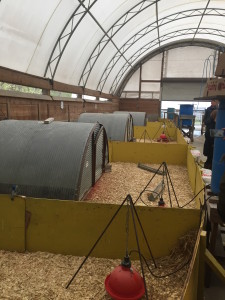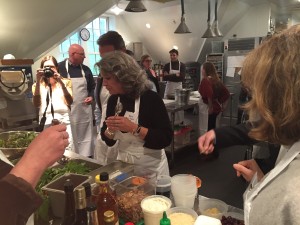Cirque du Soil: Experiencing the Groundbreaking Work at Stone Barns
Written by Marie, Posted in Miscellaneous
Just as Steve’s Urban Land Institute meeting took us to New Orleans earlier this year, it took us to Tarrytown, New York last month for a forum on food and development at Stone Barns Center for Food & Agriculture.
Most call Stone Barns a nonprofit farm and educational center. I call it a fascinating think tank for food.
 The facilities, once part of the Rockefeller estate, are exquisite. They’re overseen by Dan Barber, a chef/restaurateur, author and innovator in the food sustainability movement. Barber practices what he preaches at Blue Hill at Stone Barns and its sister restaurant, Blue Hill in Manhattan.
The facilities, once part of the Rockefeller estate, are exquisite. They’re overseen by Dan Barber, a chef/restaurateur, author and innovator in the food sustainability movement. Barber practices what he preaches at Blue Hill at Stone Barns and its sister restaurant, Blue Hill in Manhattan.
Barber spoke at length about both food and sustainability and his mission to educate the world on what it really takes to grow food. His key issue was the health of our soil and the concept of rotational crops.
For so many of us, food magically appears. We’ve gotten so far away from our food that we don’t understand what it takes to grow it. We demand so much of our soil that it gets depleted and won’t produce anything. The soil has to rest and be nourished.
Crop rotation is a system farmers use to keep the soil fertile and avoid disease. It means not planting the same thing in the same place year after year to keep up with demand.
It’s one thing to talk about it; it’s another thing to see it play out on the plate. Chef Barber served us his Rotational Risotto, which celebrates the lesser-known crops farmers plant in the rotational system. In this case, wheat is in demand, but it’s what he calls “uncoveted crops” — buckwheat, millet, rye, etc. — that nourish the soil so the wheat can shine.
It gave me a whole new appreciation for the science of farming, the agri-industry and what life must have been like 200 years ago when people didn’t have access to most foods year-round.
After the talk and tasting, we split up into three groups and rotated activities. I visited the chickens and learned about two different types: the Cornish Crown and the Freedom Ranger.
The Cornish Crown is the chicken most people eat because it’s genetically bred for breast meat and has very little bone to get the way of processing. By the time they’re eight weeks old, Cornish Crown breasts are so heavy they can barely walk. The Freedom Ranger is a heritage breed with a bonier skeletal structure. It was incredible to see them being raised side by side across the aisle from each other and taking in the differences between them at 3, 4 and 5 weeks old.
From there, I visited the hot house, where agricultural schools send seeds to see if they’re viable, and learned about different types of seeds. Then we came to my favorite part: food in action.
 Together with the culinary director at Stone Barns, I created a dish featuring every part of the radish. We made a salad with sliced egg, asparagus, a chiffonade of radish greens, pickled radish and a carrot yogurt dressing.
Together with the culinary director at Stone Barns, I created a dish featuring every part of the radish. We made a salad with sliced egg, asparagus, a chiffonade of radish greens, pickled radish and a carrot yogurt dressing.
The eating continued at Blue Hill at Stone Barns with cocktails, appetizers and a four-course dinner featuring a parsnip “steak” with bordelaise sauce and beet ketchup.
After meetings the next day, Steve and I ventured into the city and saw three plays: Blackbird with Michelle Williams; The Humans, which was nominated for a Tony award; and The Woodsman.
It was nice to get my NYC fix, but I’ve become one of those country people who doesn’t find the craziness of the city as endearing as I once did. I’m good for a couple years, then I’ll forget, go back and do it all over again.



